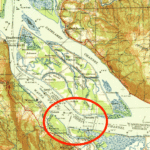All Over The Map: Mark Twain-esque locale among last Columbia ferry crossings
Dec 27, 2019, 8:46 AM
In the years before bridges and a statewide highway system, one of the only ways to cross the Columbia River with a vehicle – horse-drawn or otherwise – was by ferry. By some counts, there were as many as 50 such crossings over the Columbia, from Astoria, Oregon near the mouth, to the Canadian border.
Nowadays, just two ferry crossings remain on the Columbia in North Central Washington: At Keller in Stevens County, and at Inchelium/Gifford on the Colville Indian Reservation.
Farther downriver, only a single crossing remains: From Puget Island near Cathlamet on the Washington side, to Westport, Oregon. Puget Island was named by Lieutenant William R. Broughton in October 1792 for Puget Sound namesake Peter Puget; both Broughton and Puget were members of the expedition led by Captain George Vancouver.
Cathlamet is a classic 19th century riverside town. Its setting feels like something out of a Mark Twain story set on the Mississippi, with streets paralleling the river, dotted with industrial docks, commercial vessels and floating homes. The community is west of Longview on the banks of the Columbia River along Highway 4 and is the county seat of Wahkiakum County.
The town is named for the Kathlamet band of the Chinook people, who have lived in this area for thousands of years. It’s believed the name comes from the Chinook word “calamet,” which means “stone,” as the Columbia River near there, known as the Cathlamet Channel, was said to be fairly rocky.
European settlers moved to what became Cathlamet around 1846. That’s when James Birnie, a former employee of the Hudson’s Bay Company, set up his own trading post and store. The community may have been known informally in those years as Birnie’s Retreat or Birnie’s Trading Post.
Thanks to steamboats on the Columbia River and the Willamette River, with increasing traffic between nearby Fort Vancouver and Portland, Cathlamet grew steadily in the 1850s and 1860s.
Historian Fred Lockley wrote in the 1920s about how Cathlamet fared in the intensely cold winter of 1861-1862:
Ice rarely forms at Cathlamet, but that winter the water along the shores of the Columbia was frozen so solidly that horses and sleds could cross the river on the ice. The little steamer Multnomah with the genial Captain Hoyt as master, was frozen in at Cathlamet. The Indians had plenty of food and clothing and were happy, the passengers from the Multnomah were jolly, as pioneers always were if they had half a chance. The six weeks of cold weather were filled in with sleigh riding, games and dancing … from the hills of Cathlamet to the Columbia River. Food with the white people grew scarce, but this made no difference, for a young horse was shot for meat and served as roast beef. In the log houses and the lodges, great fires blazed and there was nothing of sorrow or fear.
Ice on the Columbia, especially in great enough quantities to allow crossing on foot or by vehicle, was more common in the years before hydroelectric dams changed the depth and flow of the mighty river. Amy Platt, of the Oregon Historical Society, wrote recently in COLUMBIA magazine that from “the 1860s until the 1930s, the Columbia and Willamette Rivers had frozen over at least eight times.”
Beginning in the 1920s as a private business venture, a ferry operated from Cathlamet to Puget Island, and from Puget Island to Westport, Oregon. A bridge from Cathlamet to Puget Island built in the late 1930s eliminated the need for that part of the run; the span is now dedicated to early Washington female elected official and Cathlamet resident Julia Butler Hansen.
Nowadays, Wahkiakum County operates a 23-car ferry called the Oscar B. It’s named for Oscar Bergseng, who worked on the ferry run starting in 1940, until he retired in 1966.
Ferry service between Washington and Oregon via the Oscar B is offered 365 days a year. The 15-minute trip is a perfect way to travel a mile or so across the river and at least a century back into Pacific Northwest transportation history.



















